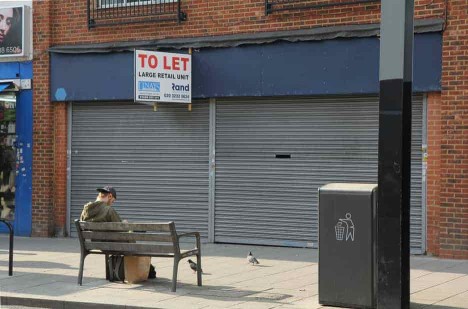Report
High Streets for All?
Matthew Noel-Tod on the instrumentalisation of artists by property developers in a time of crisis

empty shop unit, Croydon, April 2021, photo by Matthew Noel-Tod
The post-Covid recovery will see the repurposing of empty high streets and offices, with artists, or the broader creative industries, playing a key role. Several documents have been published recently which dictate the direction in which this might go: the High Streets for All Challenge from the Mayor of London, as part of the larger GLA London Economic Action Partnership and their pamphlet Flexible Workspaces on our High Streets. Large swathes of retail and office space are likely to be turned over to short-term artistic use, in a similar way to how artists inhabited previously empty industrial buildings after the decline of manufacturing.
In April 2021, the Creative Land Trust published The Future of Creative Spaces in London by Tim Gomersall, which lays out a very optimistic projection for this process. Gomersall argues that, in relation to the structures of gentrification that artists are usually caught up in, there will be ‘a reversal of the process. A healing of the system and a chance for the creative community to reclaim the spaces they had built in the first place’. Gomersall primarily refers to the cheap affordability of short-term office space in London. Earlier, in October 2020, the Financial Times had also reported how ‘the Square Mile has conjured a vision of a vibrant, diverse future where software designers and artists stroll beside derivatives traders on traffic-free streets’.
There is a slight contradiction between Gomersall’s vision and the aims of the Creative Land Trust, which seeks to avoid a situation of ‘artists unable to focus their time on their practice due to the instability inherent in relying on temporary workspace, and expert studio providers displaced from their locations despite years of building equity’. Although many may feel that artists returning to sites in central and inner east London – and a kind of empowerment which goes with feeling at the centre of something – represents a symbolic victory, this surely misframes the short-term gains against the potential for long-term losses.
In 2018, a-n The Artists Information Company published a text by Jack Hutchinson that summarised the challenges of studio providers in Greater London at that time, which, he wrote, were doing their best to keep things affordable in a difficult environment. Hutchinson went on to mention the 2014 ‘Mayor of London-commissioned Artists’ Workspace Study, which predicted the possible loss of up to 3,500 artists’ workspaces in the capital within five years’. In 2018, it seemed likely that affordable artists’ studios within London’s Zone 2 would become extremely scarce by 2020. Of course, it was impossible to foresee how Covid-19 would alter the premium and availability of commercial property in London, but rather than being the great corrector to enable artists to reclaim unaffordable spaces, the creative community as a whole might want to take this moment of change to take stock of what other forces are at play.
Much of the creative repurposing of the high street and office space will presumably be short-term. Unless freeholds or long leases change ownership, there will be an explosion of ‘meanwhile’ use contracts, akin to property guardianships. The success of property guardianships – essentially financialised squatting – in the toolkit of developers is rapidly expanding to temporary workspace use, as well as live-in guardianships. Witness here a rise in the opportunistic instrumentalisation of artists for the benefit of commercial property owners. The recently established Hypha Studios is one group aggressively using this strategy. On the surface, Hypha Studios’ model presents itself as a win-win scenario: the organisation offers free short-term studio or project space for artists and lists notable curators such as Joe Hill, director of Eastbourne’s Towner Gallery, and Catherine Wood, a senior curator at Tate Modern, as selectors, which adds credibility to the process. Another view of Hypha Studios’ business model, however, is that it is primarily a service to commercial property owners, who allow Hypha Studios to use a vacant property for a minimum of 45 days, which is enough to trigger an empty property business-rate-free window of three to six months. After three months (office and retail) or six months (industrial), if the property remains unlet/unsold, the process can be repeated, triggering another business-rate-free window. Hypha does not conceal this mode of operation – its senior adviser is Adam Walker, a chartered surveyor specialising in commercial real estate and commercial management, whilst its property consultant is Olu Akindeinde, who ‘specialises in acquisition and disposal of property’ – but the sums of money saved by commercial property owners in non-payment of business rates can be in the tens to hundreds of thousands of pounds. Once the scale of these savings are revealed, it becomes clear that giving an artist a space for 45 days is a trivial gesture.
This model is particularly pernicious in relation to established studio providers. It undercuts workspace prices in the short-term, using property which in the long-term will return to commercial use as soon as market forces dictate. Local councils, which could invest what amounts to hundreds of thousands of pounds of business rates in social facilities, lose that income; these same councils, however, are unlikely to grant long-term rate relief to studio providers that have permanent premises, a situation which leads to higher overheads for studios. The potential for millions of pounds of public funding (via the Mayor of London, LEAP, ACE and local councils) to directly or indirectly bolster this kind of temporary activity could well prove to be a long-term own goal. Policy documents often talk about ‘stakeholders’ and ‘community’ without establishing who these might be, which is particularly concerning when the long-term motivation of most London property owners remains to generate as much profit as possible.
This model is not limited to London. Hypha started primarily with properties in Sussex, but now lists sites in London, Sheffield, Ashford, Penrith and Cambridge. Another player in this area is Proposition Studios. Similarly to Hypha, Proposition uses a charity-backed-by-guardianship model to sell opportunities to artists, while also selling services to property developers. Both Hypha and Proposition use zeitgeisty ecological analogies in their mission statements: ‘the mycelial network of funghi’ for Hypha and ‘reimagining our civilisation’s role in the biosphere’ for Proposition. Proposition runs studios in central London and Derbyshire via arrangements with Oaksure Property Protection Ltd, which is connected to Oaksure Property Investment Ltd. Proposition and Oaksure share a director: Daniel Hudson. If the linguistic connotations in Hypha and Proposition speak to the art world, then Oaksure has echoes of The Wolf of Wall Street and Stratton Oakmont. Speaking to London’s Evening Standard in 2016, Hudson said of Oaksure: ‘Ours really is a win/win business.’ I am not arguing against the good that might come from individual artists having access to new and cheap space, or that there is some moral obligation for it to cost little or no money, but rather that this huge moment of opportunity shows how totally enmeshed the ‘go to’ language of arts has become in the service of capital. This tension is not new. Earlier this century the pubic/private management of the ‘Shoreditch effect’ created swathes of policy to utilise artists as economic catalysts for empty property, as detailed by David Panos in a Mute article from 2004 about the London Development Agency’s Creative London programme: ‘the plan is to extend the scheme to the private sector once it has been demonstrated to landlords that artists can act as free security guards while simultaneously rehabilitating a fallow property and increasing its value.’
Conditions, which David and I set up in 2018 in Croydon, has made use of otherwise empty spaces in the Whitgift Centre, which is also home to Turf Projects. Conditions ran one short-term project in the Whitgift pre-Covid and hopes, post-Covid, to establish another, well aware that this space is only temporarily in the service of artists. However, the main studios of Conditions were established on the opposite principal: to have control over the buildings in the long-term, via a freehold and a lease, so as to establish a reliable and sustainable space for artists. It is a tricky position to navigate and you risk being damned either way: long-term ownership makes you a landlord with financial pressures; short-term leases open you to exploitation and precariousness.
Around 2018, when a-n wrote about the challenges to London studio providers, many organisations had been setting up large new studios on the fringes of Greater London (ASC, Acme, Space). Few artists could afford to live within Zone 2 and commercial buildings there were financially well out of reach. A glut of short-term and extremely low-priced or free studio spaces now threatens to undermine many established providers. Artists, and particularly younger graduates, will pay travel costs and work peripatetically if it works out cheaper than renting a regular studio. The rush to invest in creative high streets could risk putting existing artist-studio providers with longer fixed-term commitments out of business, and the long-term result could be a net reduction in affordable creative workspace in London, once all the temporary spaces have returned to other commercial use (and the commercial owners have been kept afloat by artists’ activity). The term ‘art-washing’ is usually reserved for prettifying physically toxic practices with connections to human rights abuses or environmental destruction, and here again we see the possible rub: if art becomes the short-term saviour of the post-Covid economy, will it merely prop-up longer-term financial investments to its own detriment?
Matthew Noel-Tod is an artist and co-founder of Conditions, Croydon, a low-cost studio programme for artists.
First published in Art Monthly 446: May 2021.











